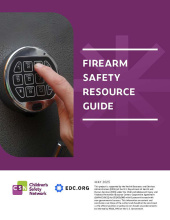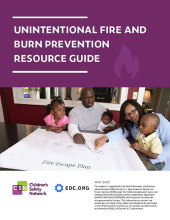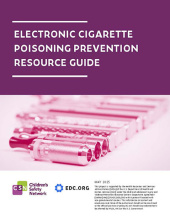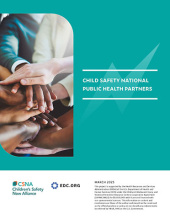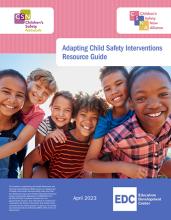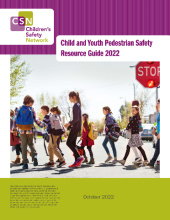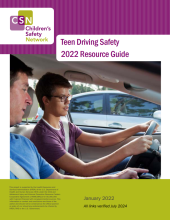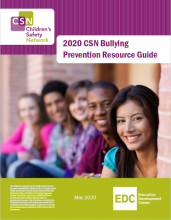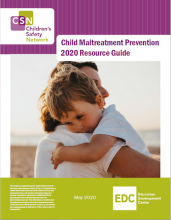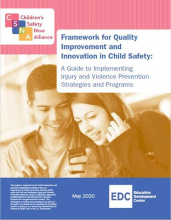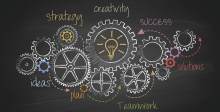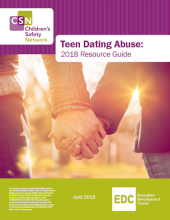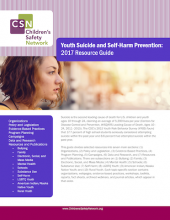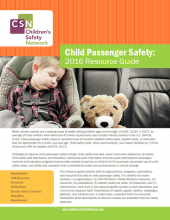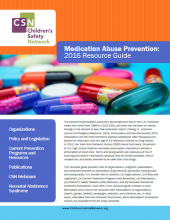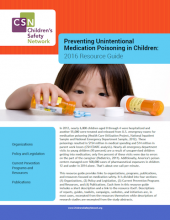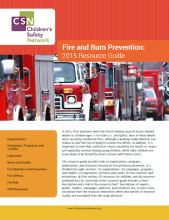CSN Resource Guides
![]() This page displays all Children’s Safety Network Resource Guides. Please feel free to download and share through Facebook, X, Pinterest, or email.
This page displays all Children’s Safety Network Resource Guides. Please feel free to download and share through Facebook, X, Pinterest, or email.
Released Date:
A firearm injury is a gunshot wound or penetrating injury from a weapon that uses a powder charge to fire a projectile, such as a handgun, rifle, or shotgun. Injuries from air- and gas-powered guns, BB guns, and pellet guns are not considered firearm injuries as these weapons do not use a powder…
Read MoreReleased Date:
Fires and burns are the fifth leading cause of unintentional injury-related deaths to infants, children, and adolescents ages <1-19 in the U.S.1 Nearly 300 U.S. infants, children, and adolescents die2 and about 80,000 are treated and released from emergency departments (ED) per year for nonfatal…
Read MoreReleased Date:
Electronic cigarettes — also known as “e-cigarettes,” “e-cigs,” “vapes,” “e-hookahs,” “vape pens,” and “electronic nicotine delivery systems”— include a wide range of battery-powered devices used to inhale nicotine and other chemicals. Although using e-cigarettes is generally thought to be less…
Read MoreReleased Date:
Title V agencies working in injury and violence prevention and child safety address a broad range of injury topics across many populations. Partnering with national level public health agencies, organizations, and networks can play an important role in increasing the reach and impact of child…
Read MoreReleased Date:
Delivering interventions that have been shown to be effective in improving desired outcomes—also referred to as evidence-based practices (EBPs)—is critical to achieving improvements in child safety. Ideally, the interventions selected are ones that best fit local needs and circumstances. But even…
Read MoreReleased Date:
Among children and adolescents ages 0 – 19 years, most pedestrian deaths occur among males, in non-metro areas, at non-intersection locations and at night.1,2 American Indian/Alaska Native and Black children ages 0 – 19 years are at higher risk for pedestrian death and injury than other racial…
Read MoreReleased Date:
In 2019, 4,356 people were killed in crashes involving young drivers (aged 15 - 20). Of these fatalities, 1,603 were young drivers.1 Teenagers contribute to, and suffer from, the consequences of motor vehicle collisions at a disproportionate rate. Teen drivers ages 16 - 19 are nearly three times as…
Read MoreReleased Date:
Bullying during childhood and adolescence is painful when it happens and can have long lasting effects, both for the bully and the victim. Despite efforts to decrease bullying, the percentage of students reporting being bullied- roughly one in five- has not changed since bullying-related data began…
Read MoreReleased Date:
Child maltreatment (including sexual, physical and emotional abuse) and neglect are serious public health problems which can be prevented. These adverse childhood experiences, resulting in harm, the potential for harm, or threat of harm among children under the age of 18 can be perpetrated by a…
Read MoreReleased Date:
Injuries and violence are leading causes of morbidity and mortality among U.S. children and adolescents. These injuries are preventable. The Children's Safety Now Alliance developed a resource guide, "CSN Framework for Quality Improvement and Innovation in Child Safety: A Guide to Implementing…
Read MoreReleased Date:
Traumatic brain injury (TBI), a condition caused by a bump, blow or jolt to the head which disrupts normal brain function, is a major cause of death and disability in the United States. Nearly 700,000 TBI-related emergency department visits, hospitalizations, and deaths occur annually in US…
Read MoreReleased Date:
Change Packages The Change Packages list the evidence-based and evidence-informed strategies that will lead to breakthrough improvement in key topic areas of child safety. The change packages are available as comprehensive resources organized across the entire socio-ecological model, and also…
Read MoreReleased Date:
Teen dating abuse is physical, sexual, or emotional abuse (including stalking) that occurs between teens and pre-teens in a relationship. It can take place in person or online, and can involve a current or past partner (CDC, 2016). Teen dating abuse is quite common, affecting around one in…
Read MoreReleased Date:
This resource was recently updated. Visit the latest version. Teenagers contribute to, and suffer from, the consequences of motor vehicle collisions at a disproportionate rate. Motor vehicle crashes are the leading cause of death for youth ages 15–20. According to the National Highway…
Read MoreReleased Date:
Suicide is the second leading cause of death for U.S. children and youth ages 10 through 24, claiming an average of 5,390 lives per year (Centers for Disease Control and Prevention, WISQARS Leading Cause of Death, Ages 10–24, 2011–2015). The CDC’s 2015 Youth Risk Behavior Survey (YRBS) found that…
Read MoreReleased Date:
Motor vehicle crashes are a leading cause of death among children ages one through 14 (CDC, 2016). In 2013, an average of three children were killed and 470 were injured every day in motor vehicle crashes in the U.S. (NHTSA, 2015). Child passenger safety requires consistent use of…
Read MoreReleased Date:
The amount of prescription painkillers prescribed and sold in the U.S. increased nearly four times from 1999 to 2010 (CDC), yet there has not been an overall change in the amount of pain that Americans report. (Chang, H., American Journal of Emergency Medicine, 2014). Prescription and over-the-…
Read MoreReleased Date:
In 2012, nearly 6,000 children aged 0 through 4 were hospitalized and another 55,000 were treated and released from U.S. emergency rooms for medication poisoning (Health Care Utilization Project, National Inpatient Sample and National Emergency Department Sample, 2012). These poisonings resulted in…
Read MoreReleased Date:
This resource was recently updated. Visit the latest version. In 2013, fires and burns were the fourth leading cause of injury-related deaths to children ages 1-18 in the U.S. (WISQARS). Most of these deaths were caused by residential fires, although a working smoke detector can…
Read MoreReleased Date:
This resource was recently updated. Visit the latest version. In the 2013 Youth Risk Behavior Survey (YRBS), 20 percent of students reported being bullied on school property and 15 percent reported being electronically bullied in the 12 months preceding the survey. Victimized youth are at…
Read More